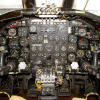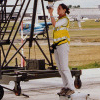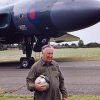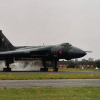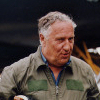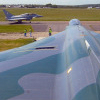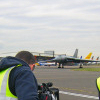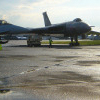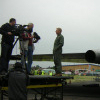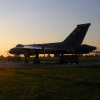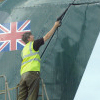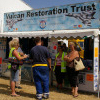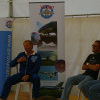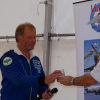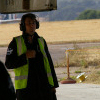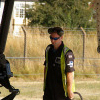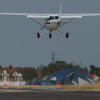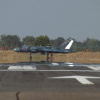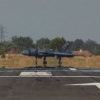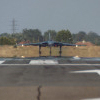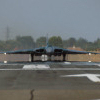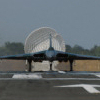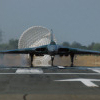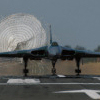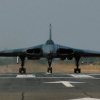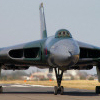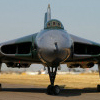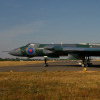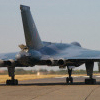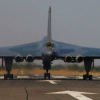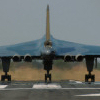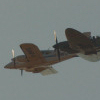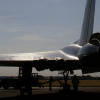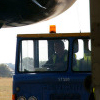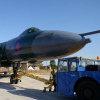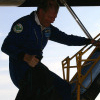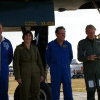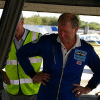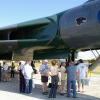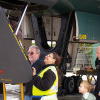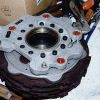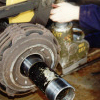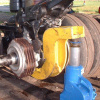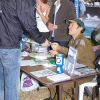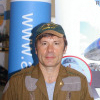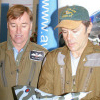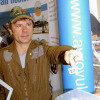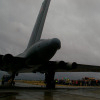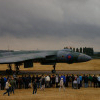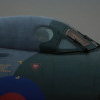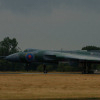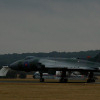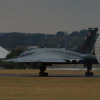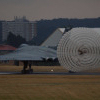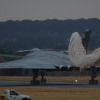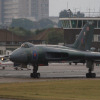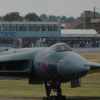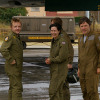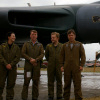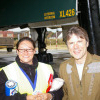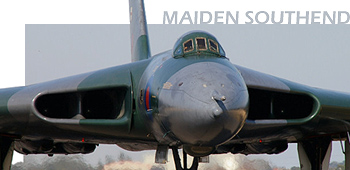
Vulcan Restoration Trust Open Day Feature Report
Saturday 12th August
August 2006 was to be an extremely busy month for the Vulcan Restoration Trust and its Avro Vulcan B2 XL426 - 'The Southend Vulcan'. Two high speed taxi runs were planned - just one week apart - with the second expected to have Iron Maiden vocalist Bruce Dickinson in the co-pilot's seat. Major brake problems and the weather were to play their part in throwing doubts over the success of the events.
covers the trials and tribulations of keeping the country's most active Avro Vulcan B2 'on the road'. Words and photography by the author.
XL426 is a star. That's not just my personal opinion, but is evidenced by her appearances on the big and small screen, and by the famous rear-ends that have graced her 'office' seats. An early bit part in the TV series 'Bugs', a cinema only advertisement for Wallis, and a staring role in a Channel 4 series titled Classic Aircraft, was followed, in July 2003, by author and newspaper columnist Frederick Forsyth acting as co-pilot for a high speed taxi run. With mini cameras fitted in the cockpit and hanging on for dear life outside, Freddy made an attempt to get the Vulcan voted as the Greatest British Plane for the Discovery Wings series of that name. The taxi run was preceded by a whole day of interviews and repeatedly walking towards and away from cameras, posing, and long periods of apparent inactivity (which would appear to be standard for the industry). Finally the go-ahead was given for the run to proceed, the VRT ground crew had finally got something to do other than soaking up rain water, Freddy had donned his 50's vintage Flash Gordon flying helmet, and camera crews had been dispersed around the airport, when unfortunately the Palouste air-start failed, requiring an emergency borrowing of a Heavylift unit which also gave problems, and all under the gaze and pressure of the 'we're losing the light luvvy' film crew. As it happens we really were losing the light, and the taxi run eventually took place approaching the evening just after an especially heavy downpour, which if nothing else, made for some great images! A whole day's filming - including having a Robinson R22 with cameraman aboard whizzing along on a parallel course at very few feet - was compressed into three minute and one minute 'sound bites' transmitted at intervals during the build-up to the voting. Despite Freddy's championing of the V-bomber, she was only placed second in the voting behind the Spitfire - but ahead of the Harrier and Concorde. Not bad I suppose!
During 2005 a Canadian film company were putting together a series of 'The World's Greatest……'. One subject was to be '…Bombers', which would be transmitted on Channel 5, and would require the filming of a Vulcan in or around the month of May. Quite fortuitously Southend has an airshow during this month and a Vulcan based at the airport and carrying out a high speed taxi run would fit the bill perfectly. During conversations between the production team and the VRT's Dave Griffiths it was mentioned that they were intending to hire Iron Maiden's Bruce Dickinson - a First Officer with airline Astraeus - as celebrity pilot for the event. Much excitement and making of plans for maximising the potential for publicity for the VRT was soon put into question by the discovery that Maiden were on tour and due to play in Poland on that day. We later discovered that Bruce had never even been contacted by the production company. Never-the-less, a seed of an idea had been sewn, and the thought of such an A-lister taking a turn at the wheel and maybe drawing a large crowd and helping to bring in some much needed funds demanded that we should try to contact Bruce ourselves, with the hope that he would be interested in such an offer..
The Trust began 2006 with plans to carry out two taxi runs in August in celebration of XL426's arrival at the Essex airport twenty years previously. The first would be for the VRT members only, the second, just a week later, would be for the general public. Would it be possible to find a route of contact with Bruce in time? Would he be interested? After much concern and frustration, finally, contact was made. Was he interested? Well, I think we would have had to fight him off with an Epee! His answer was resoundingly in the affirmative, and not only that, he was happy for us to advertise his appearance and to build up as much publicity as we could. The planning towards the two events continued with this added excitement, and the work on the aircraft continued with the added pressure of such high expectations.
There are many areas of serviceability that need to be covered in preparing an aircraft for what is essentially an aborted take-off, but the highest priority has to be the retardation. Although a brake chute was planned to be used on both occasions these have been known not to deploy correctly, so the crew have to assume that the brakes will be required to supply one hundred and more percent of the braking force required to stop XL426 from joining the road traffic at the zero six end of Southend's tarmac. Amongst all the systems aboard the aircraft, it is the brakes that get the highest priority. The hydraulic lines that supply the vital pressure, the heat packs, and the Maxarets are frequently checked and tested under load, with some of the work being sent out to the aerospace industry to be officially passed to approved limits. A Vulcan has eight brake units - with the business parts known as 'heat packs' - each of which has a number of disks sandwiched by abrasive pads to absorb the energy, plus a Maxaret, which is an early form of ABS and is 'supposed' to stop the wheel from locking up - which would risk causing a tyre to burst. That's the theory!
The morning of August 5th dawned bright and sunny, and found the hard working VRT events and engineering crews hard at work at the airport preparing for the Trust's members day event. A marquee, the well travelled VRT sales stand, toilet units and fencing had all sprung up on the area to the north side of '426's pan, and the aircraft itself was getting a final pampering in preparation for a day's showing off. Guest for the day was Brian Gardner, ex-RAF Vulcan crew, and forever to be remembered as one of the Black Buck 6 crew flying XM597 that had to divert into Rio de Janeiro's Galaeo International Airport - using fair means or foul - after suffering a refuelling probe failure on the return trip from the Falklands. Membership of the VRT brings with it the honour of being able to listen to the likes of Brian recounting such stories. Listening to a first hand account of such a historical event is very special. You could 'feel' the tension in the cockpit as the crew had to contend with an aircraft low on fuel, being refused permission to land and with two Brazilian fighters attempting to intercept them. They got the Vulcan down safely - against the wishes of ATC - but then had the added problem of trying to explain to non-English speaking controllers that it probably wasn't a good idea to be directed to an area were the aircraft would be pointing towards the airport terminals and population, seeing as they still had a Shrike anti-radar missile hanging from a pylon, hung-up and live! It had been there since picking up a more legitimate 'Argy' target down in the South Atlantic but had refused to leave the aircraft. The danger was that it still might, so thankfully the crew finally managed to get their point across and were directed to a more quiet area of the airport, at which they were pretty much put under 'house arrest' whilst the politicians attempted to calm the situation. Brazil and Argentina are not the best of friends so the local Air Force personnel soon took their RAF brethren under their own wings until eventual repatriation. The V-Bomber made it home unscathed, survived the scrapping of the V-Force, and is now to be seen at the Museum of Flight, East Fortune in Scotland.
XL426 waited patiently in the hot sun outside, knowing full well that she was the real star of the day. The ground crew had been busy topping up the engine and hydraulic fluids, pressurising the tyres and cockpit door system with nitrogen, and hooking up the ground power unit and positioning the ground equipment ready for the 'off'. Brian was joined in the 'office' for today's run by regular guest pilot Al Painter, with Geoff Lidbetter as AEO - both of who are ex-RAF Vulcan crew - and the VRT's Chief Engineer Matt Lawrence, plus the lucky winner of a raffle, Jacqui Freke. With the crew in place, the Vulcan is towed the short distance out onto the Eastern taxiway where the 'pre-flight' checks begin, the ground crew remove the tow bar and connect up the Palouste air-start and await instruction from the pilots. With clearance to start, the air-start (which is basically a small jet engine designed to produce an output of high velocity air) gets its automatic instructions via a selection in the cockpit to spin the first Olympus into life, and once the desired turbine speed is reached the fuel is added to the inflowing air and ignited. With a rumble each engine follows suit until she is sitting there creating a high-pitched whine and heat haze. As is so often the case at Southend, she remained sitting there for some considerable time awaiting clearance from Air Traffic to enter the runway thanks to a few light aircraft movements. Rather annoying given the vast differences in fuel burn between the two types! Eventually the Vulcan - glimmering in the heat haze - moves slowly onto the threshold like an athlete positioning onto the starting blocks. A few seconds of delay - and anticipation - awaiting clearance for 'take-off', then the audible evidence of throttles levers being advanced reaches everyone's ears, and rapidly this increases towards full power whilst straining against the brakes for a few seconds. The big bomber lurches forwards, gains speed, produces the trade mark elephantine howl, and soon reaches approximately 100 mph. The sound that shakes your insides and rattles your fillings suddenly stops as the crew chop the power and select 'stream' to deploy the chute. This is always a nervy moment for the VRT engineering team as the chute - which takes hours to pack and fit into the aircraft - has been known not to 'inflate' on some occasions, but today's is perfect. The massive area of nylon does its job. The crew feel the 'yank' as the chute catches the air and does what it can to dissipate some of the kinetic energy that is a Vulcan bomber travelling at high speed, but the pilots still need to stand hard on the toe brakes to continue the retardation. This they do, and as they do so - through no fault of their own - a bang and a puff of smoke are evidence that a Maxarette has failed to do its job as advertised and caused a pair of tyres to blow. The crew continued with their procedure, jettisoning the chute, and relying on the seven serviceable heat packs to stop the aircraft. There's plenty of room to spare and the crew steer over to the left side of the tarmac to prepare for a one-eighty right turn to back-track. They have to wait for a pick-up truck to collect the discarded brake chute, giving time for Chief Engineer Matt Lawrence to open the crew door and inspect the main undercarriage to ensure that there is no damage done, and that XL426 is safe to continue back to the pan. Thankfully all is well, and the Vulcan returns to the taxiway adjacent to the pan and shuts down. As the turbines wind down we were treated to an unscheduled flypast by a Spitfire and a light twin in close formation carrying out an air-to-air photo sortie. Very nice.
The ground crew promptly hooked up the tow bar, so that Martin 'Tug' White could manoeuvre the large aircraft into what must - from Martin's viewpoint - look like a very small pan. As well as positioning the Vulcan just right so that it stays on the narrow tarmac leading to the pan, he must also avoid turning the nose leg too far. If he does so it will damage the nose wheel steering, and probably lead to him being lynched by the rest of the ground crew. The nose wheel steering was one of the priority repair jobs in the early days of restoring XL426 to taxiing condition, and took many many months of blood, sweat and tears to complete - much like many other jobs on the aircraft - and would be a major heart break to the team. Thankfully - but not surprisingly - Martin was able to place '426 perfectly in place, and quick removal of the tow-bar allowed the crew door to be opened, and the sweat drenched crew to be released from the oven-like cockpit, to much applause from the crowd of VRT members. After posing for crew photos, Brian had a look at the holed tyres and apologised most profusely to the team, but Matt insisted quite rightly that it wasn't any fault of the crew, but of the unit. And it began to hit home that we had a problem. The VRT had advertised to the World that a taxi-run would be taking place on the following Saturday, with an international rock star at the controls too. Matt, being responsible for the safe running of the aircraft, dropped the bomb-shell on the team that, quite rightly, without a serviceable brake system, the run could not take place. This brought with it not only any embarrassment of apologising to the public, to Bruce and to the media for the disappointment, but also the loss of much needed gate receipts required to support the upkeep of 'The Southend Vulcan'. This was serious. All the team have full-time day jobs, new replacement items are not available, and the Trust simply cannot afford to pay the going aerospace industry rate for repairing and servicing parts. While the appreciative crowd mingled around and under the aircraft, Matt first organised a change of wheel to get '426 back sitting on a full set of serviceable rubber, then began weighing up the options for enabling a high-speed taxi-run to take place in just six full days - or to cancel. Massive pressure, extreme responsibility.
As the happy crowds drifted away home, an impromptu VRT crisis meeting was held under the aircraft - an aircraft that always seems to throw a strop at vital times, as stars do!
During the week the engineering crew gave up much of their valuable time sorting through the VRT's stock of brake-related spares. The Trust have a large selection of brake units gathered from various sources, but all of which are at least twenty years old, and must be regarded as unserviceable until proven otherwise. The team have the ability to pressure test brake units using a rig which pumps hydraulic fluid into the unit to a given pressure, but cannot test Maxarets, so a few were sent away to be tested using precious VRT funds - thankfully passing. By the end of the week a freshly Maxaretted heat-pack was fitted to the aircraft - but there was no time to test it under load...
And so it came. Saturday 12 August 2006. Possibly the most important day in the history of the Vulcan Restoration Trust for many years dawned grey and wet. We had an aircraft that was still being worked on and awaiting a decision on its serviceability, and no news from Bruce Dickinson. As the first public visitors paid the full price at the gate to see an Avro Vulcan B2 carrying out a high-speed taxi run with an international rock star in the cockpit, we could not at this stage guarantee that we could deliver on either of those counts. Worse was to come. Power was applied to the aircraft, the hydraulic systems were run-up and braking pressure applied. Initial jubilation that the newly fitted unit was holding pressure was quickly killed off by one of the previously serviceable packs which had decided that having a fully working brake system was no fun so had begun emptying fluid onto the pan! What had we done to deserve this? There was no option but to remove the unit and put together a new one, test it, and get it back on the aircraft in double quick time. No news yet from Bruce. And it was still raining. To make matters worse, a Scotsman had arrived. Group Captain Bill Burnett, ex-RAF Vulcan pilot, and pilot in command for the day - and therefore extremely reliant on the stopping qualities of the brake system - was now looking on as a heat-pack was broken down into its constituent parts, cleaned and inspected, and re-built using replacement 'O-ring' seals. The unit was hooked up to the test rig. This was it. With just a few hours to go, if this unit failed the pressure test then it would be unlikely that the high speed run could take place. All eyes were on the pressure gauge as it gradually increased to the required figure. Once there, those same eyes altered target to the brake unit, looking for the slightest of damp patches. Dry as a bone. Fantastic! Like a new-born baby it was whisked off to be fitted to the aircraft, now surrounded by the public, a large proportion of which were wearing black T-Shirts, long hair, denim and/or leather, and some were carrying records and CDs, and even a couple of guitars were spotted. Items presumably brought along to be autographed. By whom? Then Bruce rang. He would be at Rochford station soon, ready to be collected and play his part in the day's proceedings. Things were looking up. Except that by looking up, we could see that the weather still didn't want to play. The prolonged greyness was clearly keeping people away, but at least those that had decided to come were most likely going to see what they'd come to see, as the rebuilt brake unit was now in place and leak-free.
On arrival Bruce was escorted the short distance from the gate to the VRT caravan to change into his flying suit, a journey that seemed to take forever as he was continuously stopped to sign all manor of items and pose with all manor of odd looking people for photographs to be taken. At this point we didn't really have a plan. We'd concentrated on actually 'booking' Bruce, and then fretting over whether he would actually turn up, but didn't know what we should expect from him - if anything! He might prefer to 'hide' in the flying club until called to duty, and then disappear off home. We needn't have worried. He was exceptionally interested in the Trust, the aircraft, what we were about, and especially what he could do to help us keep the public happy and bring in some more funds from the day. With Bruce set up behind a table a long queue formed to pay a small fee for his autograph, either upon their own items, or on items purchased from the VRT souvenir stand. Flashes popped continuously, and people were happy. We were happy, and even the Scotsman was happy because the aircraft was happy.
Two seats on the aircraft had been reserved for the public. One to be sold by auction, and one to be raffled. With Bruce drawing the winning raffle ticket, it was time to get the crew and guests together for the 'off'. After a safety briefing the crew squeezed into the confines of the cockpit. This is something that always surprises the public. Once again Carol and Fee - our girls who look after the day's cockpit visits - have had to spend much of the day explaining why so few people can go up the crew ladder at any one time. A Vulcan cockpit accommodates two pilots - who sit up high with a letter-box like view out of the screen - and three rear crew who's job it is to get the aircraft safely to and from a target, and not much else - apart from the highlights of the tour commentary, the can-heaters and the pee-tube! It can also get very hot, even on a damp day like this.
With the crews in place inside and outside the aircraft, XL426 was towed out onto the Eastern taxiway in a procedure exactly the same as the previous Saturday. This time though, as the loud levers were pushed forward, the might of Olympus lifted a cloud of spray from Southend's runway, as the Vulcan once again powered down the oh-so-short runway and streamed another perfect brake chute, before coming safely to a stop - with an almost audible sigh of relief from the engineering team. Knowing full well that she wouldn't be allowed to leave the pan if there was any doubt as to the effectiveness of any of her systems still leaves a little bit of room for apprehension, however unfounded. '426 weaved her way around the southern taxiways, passing the terminal building and the hangers with various airliners in assorted colour schemes and states of repair, which I always think looks so surreal. Back on the pan, the cockpit disgorges its human contents, all of which appear to have been turned into Cheshire cats. Even the Scotsman! Perhaps he found a penny that was dropped by a member of public.
The smiles had spread to the engineering team too, as the pressure lifted from their shoulders, and the realisation set in that they had done it, against almost overwhelming odds. Two taxi runs. Two open days. Two sets of crowds entertained, fed, watered, plundered for cash, and hopefully taking away the memories of a great day out - whatever the weather.
The camera flashes continued to pop as Avro Vulcan B2 XL426 was packed away. Still looking great at 44 years of age, the old warhorse continues to do what she does best - being the centre of attention, be that by throwing tantrums or by a perfect performance. A true star.

